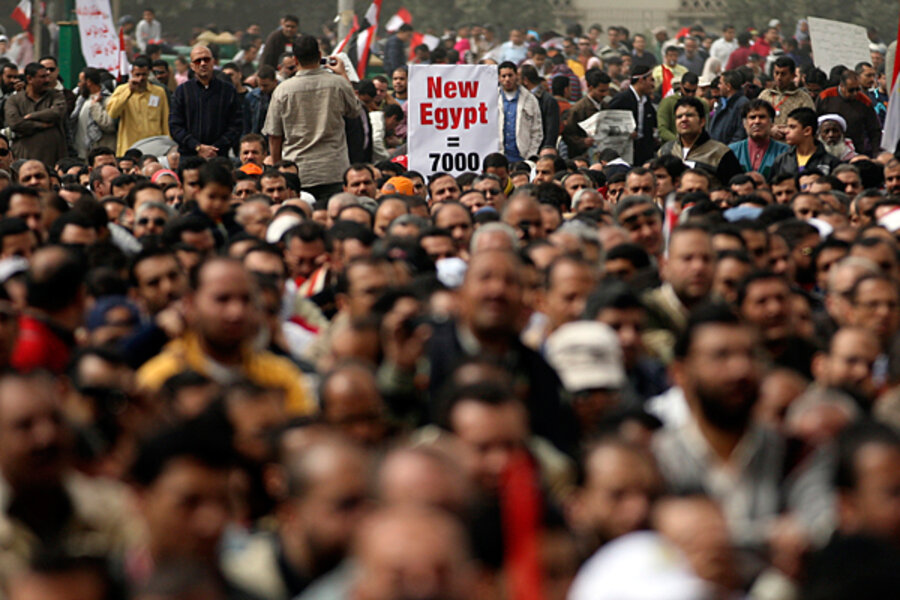Egyptians protest in Tahrir, angry over new cabinet
Loading...
| Cairo
Egyptians returned to Tahrir Square today to push for the fulfillment of the revolution that swept former president Hosni Mubarak from power two weeks ago.
Protesters say not enough has changed so far, and are particularly angry that the new cabinet sworn in this week is still headed by Prime Minister Ahmed Shafiq, a Mubarak loyalist who was appointed by the former president himself before he was toppled.
“This is not what hundreds of people died to achieve,” says Mahmoud Ahmed Metwaly, a curator at Mohamed Mahmoud Khalil museum who participated in the protests from the beginning and watched as some protesters were shot by snipers. “Ahmed Shafiq is a student of Mubarak. We have demanded a new beginning, and Ahmed Shafiq is not a part of it. We refuse him.”
The protest underlines that in Egypt, as in Tunisia, toppling the dictator is only the beginning. Erasing a deeply-rooted regime of corruption and injustice may prove the most difficult part.
A month after the popular uprising began, the emergency law that has severely curtailed civil freedoms since 1981 is still in effect. And the security apparatus of the state is still intact. The newly appointed cabinet features some new faces but retains veterans such as Mr. Shafiq in key posts. The military council now ruling the country has asked to the cabinet to remain until new elections are held.
The military council has vowed to end the emergency law, but has made no indication it will do so before it holds new elections, which it has said will be within six months. On Thursday the council released a statement on its Facebook page promising that there will be “no return to the past,” saying it is working to achieve the hopes and aspirations of the people. It also warned against attempts to create sectarian strife.
But many protesters voiced concern that Mubarak loyalists were trying to sabotage their movement. “Counterrevolution” was a buzzword among the crowd.
Solidarity with Libya
As Egyptians tried to finish what they started by holding rallies nationwide, protesters inspired by the success of Egypt and Tunisia gathered in Arab capitals across the region. Tens of thousands marched in Bahrain and Yemen to demand the resignation of their governments. Jordanians protested as well, and thousands of Iraqis staged a "Day of Rage" in Baghdad, clashing with security forces. A large protest was also held in Tunisia, where protesters have similar complaints to Egyptians.
And in neighboring Libya, fierce fighting moved closer to Muammar Qaddafi's stronghold in and around Tripoli. Egyptians expressed solidarity with Libyans at the protest Friday, with some waving the pre-Qaddafi Libyan flag that has become a symbol for the resistance.
Though the protesters in Cairo were firm in their demands, the gathering fell short of the hoped-for million attendees and the atmosphere was at times one of celebration. Vendors sold popcorn and ice cream, and thousands of Egyptian flags waved above the crowd. Children toddled through the crowd with Egyptian flags painted on their faces.
Keeping up the pressure
Protesters acknowledged they would need to keep up the pressure in order to be successful in forcing Shafiq and other Mubarak-era figures to resign. Much of their enmity is focused on Shafiq and the foreign and defense ministers, also from Mubarak’s regime. Interior Minister Mahmoud Wagdy is also attracting anger.
“It’s still a revolution in the making,” said analyst Ibrahim El Houdaiby, speaking in the middle of the square Friday. “I think Shafiq still doesn’t recognize the fact that a revolution took place.” He predicts it will take more pressure to force Shafiq and other Mubarak cronies out, as well as to dismantle the state security apparatus.
Egyptians protested in the suburb of Maadi Thursday, burning a police car, after a police officer shot a minibus driver during an altercation, illustrating the anger that is still present over the torture, abuse, and attitude of impunity perpetrated by police and security forces for years.
“This is the one area of consensus,” says Houdaiby. “No one wants to see the police acting the way they did.”
In Tahrir, the signs of the protests have been cleaned up, but the memories of what happened there are not gone. Abdullah El Fakharany, who participated in the protests from the very beginning, points to the spot where on Feb. 2 government thugs violently attacked the peaceful protesters, including him, charging the crowd on camels and horses and hurling chunks of concrete at them.
“That happened under Ahmed Shafiq’s government,” he said. “Ahmed Shafiq was chosen by Mubarak. We want a government chosen by the people through elections.”





